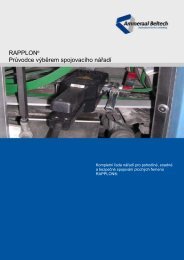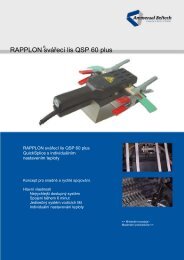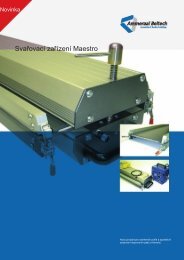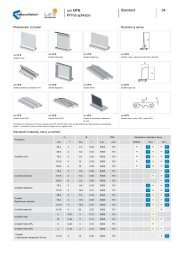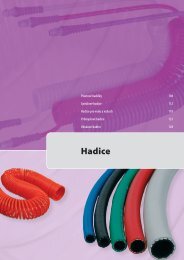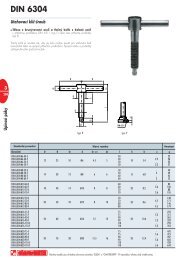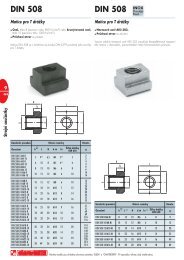- Page 1 and 2:
GBTiming Belts Catalogue» Precise
- Page 3 and 4:
ProductsThe largest product range w
- Page 5 and 6:
List of formula signsList of formul
- Page 7:
IntroductionA comprehensive range f
- Page 10 and 11:
NomenclatureNomenclature Timing Bel
- Page 12 and 13:
Timing beltsPU Linear T2,5 steel co
- Page 14 and 15:
10 Timing beltsPU Moulded T2,5 stee
- Page 16 and 17:
12Timing beltsPower Rating TablePU
- Page 18 and 19:
14Timing beltsPU Linear/Torque T5 s
- Page 20:
16Timing beltsPU Linear/Torque T5 A
- Page 23 and 24:
Pulleys19Pulleys PU Moulded T5 stee
- Page 25 and 26:
Pulleys21Pulleys PU Moulded DT5 ste
- Page 27 and 28:
Timing belts23Power Rating TablePU
- Page 29 and 30:
Pulleys25Pulleys PU Linear/Torque T
- Page 31 and 32:
Pulleys27Pulleys PU Linear/Torque T
- Page 33 and 34:
Pulleys29Pulleys PU Moulded T10 ste
- Page 35 and 36:
Pulleys31Pulleys PU Moulded DT10 st
- Page 37 and 38:
Timing belts33Power Rating TablePU
- Page 39 and 40:
Pulleys35Pulleys PU Linear/Torque T
- Page 41 and 42:
Pulleys37Pulleys PU Linear/Torque T
- Page 43 and 44:
Pulleys39Pulleys PU Linear/Torque A
- Page 45 and 46:
Pulleys41Pulleys PU Moulded AT5 ste
- Page 47 and 48:
Timing belts43Power Rating TablePU
- Page 49 and 50:
Pulleys45Pulleys PU Linear/Torque A
- Page 51 and 52:
Pulleys47Pulleys PU Moulded AT10 st
- Page 53 and 54:
Timing belts49Power Rating TablePU
- Page 55 and 56:
Pulleys51Pulleys PU Linear/Torque A
- Page 57 and 58:
Pulleys53Pulleys PU Linear/Torque A
- Page 59 and 60:
Pulleys55Pulleys PU Linear/Torque A
- Page 61 and 62:
Pulleys57Pulleys PU Linear/Torque A
- Page 63 and 64:
Pulleys59Pulleys PU Linear HTD3M st
- Page 65 and 66:
Pulleys61Pulleys PU Linear/Torque H
- Page 67 and 68:
Pulleys63Pulleys PU Linear/Torque H
- Page 69 and 70:
Pulleys65Pulleys PU Linear/Torque H
- Page 71 and 72:
Pulleys67Pulleys PU Linear/Torque S
- Page 73 and 74:
Pulleys69Pulleys PU Linear/Torque S
- Page 75 and 76:
Pulleys71Pulleys PU Moulded MXL ste
- Page 77 and 78:
Timing belts73Power Rating TablePU
- Page 79 and 80:
Pulleys75Pulleys PU Linear/Torque X
- Page 81 and 82:
Pulleys77Pulleys PU Linear XL Arami
- Page 83 and 84:
Pulleys79Pulleys PU Moulded XL stee
- Page 85 and 86:
Timing belts81Power Rating TablePU
- Page 87 and 88:
Pulleys83Pulleys PU Linear/Torque L
- Page 89 and 90:
Pulleys85Pulleys PU Linear L Aramid
- Page 91 and 92: Pulleys87Pulleys PU Moulded L steel
- Page 93 and 94: Timing belts89Power Rating TablePU
- Page 95 and 96: Pulleys91Pulleys PU Linear/Torque H
- Page 97 and 98: Pulleys93Pulleys PU Linear H Aramid
- Page 99 and 100: Pulleys95Pulleys PU Moulded H steel
- Page 101 and 102: Pulleys97Pulleys PU Linear/Torque X
- Page 103 and 104: Pulleys99Pulleys PU Linear XH Arami
- Page 105 and 106: Pulleys101Pulleys PU Linear/Torque
- Page 107 and 108: Pulleys103Pulleys PU Linear/Torque
- Page 109 and 110: Timing belts105PU Linear TK10 steel
- Page 111 and 112: Timing belts107PU Linear ATK10 stee
- Page 113 and 114: Timing belts109PU Linear/Torque F2
- Page 115 and 116: Feasibility Tables111Feasibility Ta
- Page 117 and 118: Mechanical Fastener for PU Linear t
- Page 119 and 120: Integral V-Guides115Integral V-Guid
- Page 121 and 122: Cleats117Cleats for PU-Linear and P
- Page 123 and 124: Cleats119Cleats for PU-Linear and P
- Page 125 and 126: Cleats121Some examples of complex c
- Page 127 and 128: Covering Materials123Covering Mater
- Page 129 and 130: Covering Materials125Covering Mater
- Page 131 and 132: Covering Materials127Covering Mater
- Page 133 and 134: Timing Belt Pulleys129Timing Belt P
- Page 135 and 136: Application examples131Application
- Page 137 and 138: Application examples133Application
- Page 139 and 140: Calculation program for timing belt
- Page 141: Specific spring ratio / Storage of
- Page 145 and 146: List of formula signs141List of for
- Page 147 and 148: Calculation Parameters143Calculatio
- Page 149 and 150: Calculation Parameters145Calculatio
- Page 151 and 152: Calculation Parameters147Calculatio
- Page 153 and 154: Calculation Parameters149Calculatio
- Page 155 and 156: Calculation Examples151Calculation
- Page 157 and 158: Calculation Examples153Calculation
- Page 159 and 160: Calculation Examples155Calculation
- Page 161 and 162: Installation157Installation» Calcu
- Page 163 and 164: Installation159Installation» Handl
- Page 165: Your global contactInternational He



